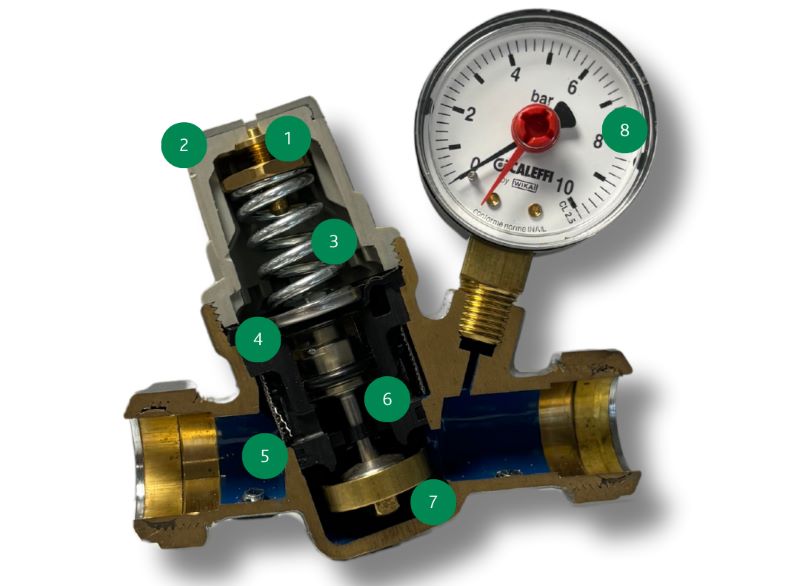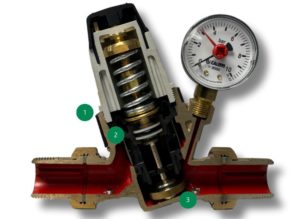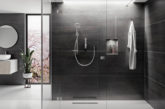
Ed Morris, Technical Manager at Altecnic, delves into the inner workings of two pressure reducing valves: the Caleffi Series 533 PRV and the Caleffi Series 535 High Temperature PRV.
A pressure reducing valve (PRV) is an essential device in plumbing applications, designed to regulate and maintain a constant downstream pressure, regardless of fluctuations in the incoming pressure. By controlling the pressure, PRVs protect appliances and systems from damage, conserve energy, and optimise performance.
The Caleffi Series 533 Pressure Reducing Valve (pictured above)
The Caleffi Series 533 is a widely used PRV in residential and light commercial applications. The core components of this valve include:
- Adjusting screw The adjusting screw is located at the top of the valve and plays a critical role in setting the desired downstream pressure. By tightening or loosening the screw, the tension on the internal spring changes, which alters the force applied to the diaphragm. This controls the outlet pressure. The adjusting screw allows for the valve’s performance to meet specific system requirements.
- Cover The cover of the pressure reducing valve encloses the upper part of the valve, protecting critical components such as the adjusting screw and spring from external elements like dust, moisture, and debris.
- Spring The adjustable spring is one of the most crucial parts of the PRV. The spring is located above the diaphragm and is compressed or relaxed to adjust the set pressure. The amount of tension in the spring determines the force exerted on the diaphragm, thus controlling the pressure on the downstream side.
- Diaphragm The diaphragm is a flexible membrane that responds to the pressure differential between the inlet and the outlet. When the downstream pressure exceeds the set value, the diaphragm pushes against the spring, reducing the flow. When the downstream pressure drops, the diaphragm relaxes, allowing more water to pass through.
- Filter Mesh The Series 533 includes an integrated filter mesh, which filters out impurities and debris from the incoming water before it reaches the sensitive internal components. This helps to prevent clogging and prolongs the valve’s lifespan.
- Control Stem The control stem acts as an intermediary between the spring and the valve disk. When the adjusting screw changes the spring’s compression, the control stem transmits this force down to the valve disk. As the control stem moves up or down, it either allows more water to flow or restricts it, which helps fine-tune the pressure output.
- Seat and Valve Disk At the heart of the PRV’s control mechanism is the seat and valve disk. The seat is a surface that the valve disk presses against to stop or allow water flow. As the diaphragm moves, it either lifts the valve disk off the seat to allow flow or presses it down to reduce flow, thus modulating the pressure.
- Pressure Gauge Ports
For easy monitoring, the Series 533 includes ports where pressure gauges can be attached to measure both upstream and downstream pressures. This allows for easy calibration and troubleshooting of the valve.
The Caleffi Series 535H: High Temperature Applications
While the Series 533 is designed for standard water systems, the Caleffi Series 535H PRV is specifically engineered for high-temperature applications, such as hot water systems where temperatures do not exceed 80°C. The basic operation remains similar, but the materials and design are modified to handle more extreme conditions.
Key Differences in the Series 535H:

- Thermally Resistant Valve Body The valve body of the Series 535H is built with materials capable of withstanding higher temperatures. This ensures that the valve performs consistently in environments where traditional valves would fail.
- High-Temperature Diaphragm The diaphragm in the Series 535H is made from heat-resistant materials like EPDM (ethylene propylene diene monomer) or PTFE (polytetrafluoroethylene). These materials can endure high temperatures without losing flexibility or structural integrity, ensuring consistent pressure regulation even under thermal stress.
- Thermally Optimised Seat and Valve Disk The seat and valve disk in the Series 535 are also upgraded to withstand the intense heat of steam or high-temperature water.












